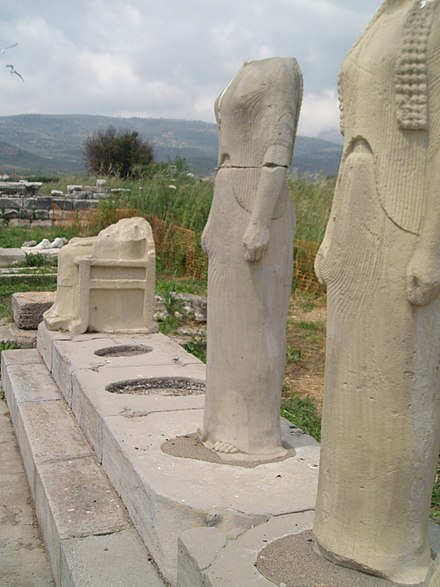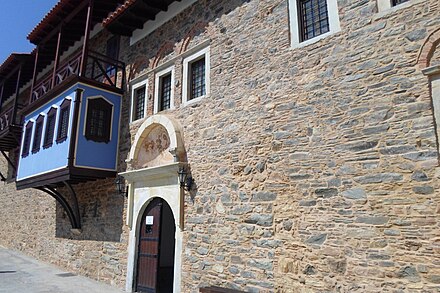Samos - Greek island in Aegean Sea
Samos is an island in the North Aegean Sea and one of the East Aegean Islands. Its capital is the town of Samos, formerly known as Vathi. The Samians still call their capital Vathi instead of Samos. If you need oral directions ask for Vathi, but if you look on the map or at the road signs, you should look for Samos. In this guide the name Vathi is used for the capital of the island.
The island lies very close to the Turkish mainland (the Mycale Strait, the channel that separates the island from the Dilek Peninsula of Asia Minor, is less than 2 km across) and is a popular stopping off point for travellers between the two countries as it lies on the route between Athens and Izmir. Tourist season in Samos, when you can expect much higher prices, begins the first week of May.
Understand
History
Samos was the birthplace of many eminent personalities, philosophers, scientists and great artists. Among them are:
Aesop, Agatharchus, Aristarchus, Colaeus, Conon, Creophylus, Damo, Epicurus, Hermodamas, Melissa, Melissus, Myia, Phyto, Pythagoras, Semonides, Rhoecus, and Theodorus
Samos has been inhabited since the 4th millennium BC; its history is both long and interesting. The earliest inhabitants were Pelasgian tribes, before the invasion of what became the classical Greeks.
The first mythological king of Samos was Ancaeus, a hero of the Argonautic Expedition who, following an oracle of Delphi, colonized the island with Arcadians and other Achaeans. Ancaeus build the first wooden temple and placed in it the golden status of goddess Hera. According to mythology, Hera was born on the banks of the river Imvras and was the protector of Samos.
Around the 11th century BC another Greek tribe, the Ionians, came to dominate the island.
Pythagoras
At the time of Polycrates, Pythagoras was born in Samos, descending from the lineage of Ancaeus. Having studied first in Samos, he continued his studies at Miletus, Phoenicia, Egypt and Babylon. Then he returned to Samos and established a school. Chased by Polycrates he left and following initiations in Orphic mysteries at Delphi, Delos and Idaean Dactyls of Crete he arrived in Croton of Magna Grecia where he taught for many years.
During the reign of Polycrates (546 - 522 BC) Samos reached its pinnacle. Polycrates built a fleet of one hundred penteconters (known as Samainas), strengthened the army, expanded city’s fortifications and founded colonies, establishing naval supremacy in the Aegean Sea. Samos’s strength and the imposing temple of Hera attracted relationships and gifts from all the kingdoms of the known world.
After Polycrates' death, Samos was taken by the Persians. In 499 BC Samos joined the general revolt of the Ionian city-states against Persia, which failed with heavy consequences for the Greeks of the East. Then came the Persian Wars, with the battles of Marathon, Thermopylae, Salamis and Plataea, during which Samos was already enslaved to the Persians. On the same day of the battle of Plataea, was also carried out the naval landing of Mycale (479 BC) in which, Samians were both the instigators of the battle and the fathers of the victory, averting the Persian threat forever.
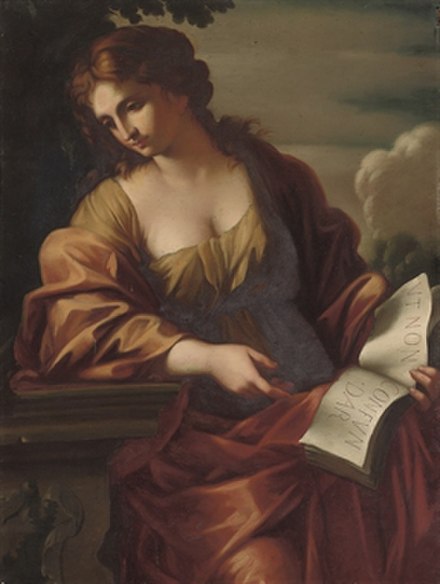 Then the Delian League was founded where Samos participated in able parity with Athens due to its naval supremacy. This supremacy annoyed Athens which, for an insignificant cause, organized an expedition led by Pericles against the Samians who, after a protracted siege, were forced to capitulate. The Athenians imposed forcibly a democratic regime and from then on, violent confrontations started between the oligarchs and democrats which lasted for generations, weakened Samos and led to a gradual decline. Plans and efforts for dominance of Athenians, Spartans, Macedonians, Hellenistic kingdoms and Rome, included also Samos for its excellent port and its position.
Then the Delian League was founded where Samos participated in able parity with Athens due to its naval supremacy. This supremacy annoyed Athens which, for an insignificant cause, organized an expedition led by Pericles against the Samians who, after a protracted siege, were forced to capitulate. The Athenians imposed forcibly a democratic regime and from then on, violent confrontations started between the oligarchs and democrats which lasted for generations, weakened Samos and led to a gradual decline. Plans and efforts for dominance of Athenians, Spartans, Macedonians, Hellenistic kingdoms and Rome, included also Samos for its excellent port and its position.
.jpg/440px-1963_Cleopatra_trailer_screenshot_(23).jpg) The new order came with the gradual dominance of Rome in the second century BC, the inclusion of Samians into the subjugated of Roman Empire, the moving of cultural treasures of Samos to Rome and the transfer of island's defense to the will of a central sway which in many crunches was absent.
The new order came with the gradual dominance of Rome in the second century BC, the inclusion of Samians into the subjugated of Roman Empire, the moving of cultural treasures of Samos to Rome and the transfer of island's defense to the will of a central sway which in many crunches was absent.
From the 4th century AD, Samos was incorporated into Byzantium becoming the seat of the namesake theme, named also "theme of the sailors" as it served chiefly to provide ships and troops for the Byzantine navy.
Following the disruption of the empire by the 4th Crusade in 1204 (Frankokratia), the island was attributed to the dominance of Genoa and the economic exploitation of Maona which was the first historical colonial trading company. Under the ruling of Genoa, the island was hard hit by several attacks and sacks by invaders and pirates, mainly Saracens. Genoese, unable to cope with piracy decided in 1475 to quit the island and retire in Chios. The coastline of the island devastated and the inhabitants either migrated to adjacent islands or pulled off in mountain areas by establishing settlements that were (and still are) not visible from the sea. As a result, travelers, navigators and pirates believed that the island was completely abandoned.
In 1562, the corsair nicknamed Occhiali, a Calabrian renegade to the service of Turkish navy, prompted by his helmsman Nikolaos Sarakinis, asked from the Sultan to take Samos as fief for the services he had offered, with the proviso that only Christians would be allowed to re-inhabit the island. Special privileges were also to be conceded and especially a kind of self-government under the rule of the Sultan. The Sultan accepted, considering perhaps that the island was uninhabited and therefore useless in terms of taxes. Some years later, when the Sultan demanded to take the colonization records to Constantinople, the ship that carried them sank into the sea. Many descendants of migrated Samians returned to the island. The privileges attracted also settlers from other parts of Greece and especially unsubdued remains of Byzantine soldiers who were constantly displaced, with their families, towards any territories were still free.
In 1821 the island participated in the Greek revolution but when the independence of Greek state was recognized in 1830, according to the treaty establishing the Greek State, Samos was not included within the limits of Greece. Instead, it was declared as an autonomous Principality tributary to the Sultan.
Finally in 1912 following a last revolution, the union of Samos with Greece was inflicted. Economy and social life of the island, begun flourishing again, and today, despite the destruction due to forest fires which happen almost every year, it remains green and inviting.
Get in
By boat
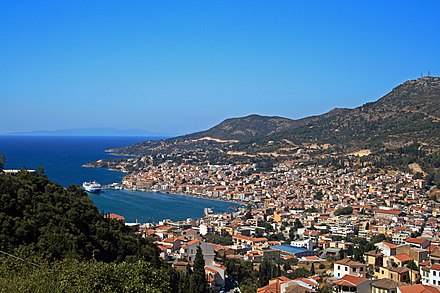
At Samos town (Vathy) there are two places ships dock, which are 3km apart and takes about 30 minutes by foot. One is the "Samos Ferriboat dock" on the west of the harbour, which domestic ferries dock (Blue Star etc). On the east side of the harbour is the "Vathy Port" which contains customs controls and is where ferries to and from Turkey dock.
Hydrofoils to the Dodecanese islands depart regularly from Vathi and Pythagorion.
There are foot-passenger ferries daily Apr-Oct from Kuşadası in Turkey operated by Meander Travel. These leave around 09:00 for a one-hour sailing to Vathi and return around 17:00, so a day-trip is possible from Kuşadası to Samos but not the reverse. In 2022 a day-trip is €36 adult and an open return is €47. Hellenic Seaways and Dodekanisos Seaways no longer longer sail this route. See Turkey#Get in for entry requirements at Kuşadası.
Mooring facilities
.jpg/440px-Pythagorio(5).jpg) Every port is suitable for yacht berthing, however Vathi and Karlovassi are getting swell when north winds blow while Vathi is exposed to the strong southern winds. Apart of Pythagorion port itself which provides good shelter at any weather, the bay where Pythagorion port locates provides good shelter from the prevailing summer north winds and is suitable for staying on anchor (the muddy bottom provides excellent holding). Also, Samos Marina located eastern of Pythagorion in a walking distance of 900 m (0.5 mi), provides good all-round shelter.
Every port is suitable for yacht berthing, however Vathi and Karlovassi are getting swell when north winds blow while Vathi is exposed to the strong southern winds. Apart of Pythagorion port itself which provides good shelter at any weather, the bay where Pythagorion port locates provides good shelter from the prevailing summer north winds and is suitable for staying on anchor (the muddy bottom provides excellent holding). Also, Samos Marina located eastern of Pythagorion in a walking distance of 900 m (0.5 mi), provides good all-round shelter.
Samos Marina, Pythagorion, 831 03, Samos, Greece, 37.691581°, 26.953942°, +30 22730 61600, info@samosmarina.gr. Ability to host a total of 260 vessels, including 10 berths arranged for super-yachts with a length over 25 m.
By plane
- Samos International Airport (IATA: SMI), 37.69°, 26.911667°. There are daily flights from Athens (55 minutes) and from Thessaloniki (65 minutes).
Airlines/destinations:
- Austrian Airlines seasonally flies from Vienna.
- Blue Panorama Airlines seasonally flies from Bologna
- Condor seasonally flies from Berlin–Schönefeld, Düsseldorf, Frankfurt, Hannover, Munich, Stuttgart
- Corendon Airlines seasonally flies from Amsterdam
- Edelweiss Air seasonally flies from Zurich
- Eurowings seasonally flies from Dusseldorf and Vienna
- Neos seasonally flies from Milan–Malpensa and Verona
- Olympic Air (dead link: January 2023) flies from Athens and Thessaloniki.
- Sky Express (dead link: January 2023) flies from Athens, Chios, Lemnos, Mytilene, Rhodes, and Thessaloniki
- SmartWings flies seasonally from Prague
- Swiss International Airlines Zurich
- Transavia flies seasonally from Amsterdam
- TUI Airways flies seasonally from Amsterdam, Brussels, London-Gatwick
- Volotea seasonally flies from Venice
Flights arrive near the old capital of Pythagorion.
Get around
The island has buses although these will not operate on some public holidays e.g. May 1st. There are numerous rental agencies near the port in the city of Samos which rent out cars, motorbikes, scooters and quadbikes. Many of these are open late and so it is possible to rent a motorbike from early morning until 21:00 or 22:00 for €10 per day. With your own transport, you can explore much of the island in a day or two. There are also taxis.
The main town of Samos can easily be explored on foot although there are some steep roads/steps away from the sea front as the town reaches the foot of the hills.
The archaeological sites around Pythagorion can be explored on foot or by bike. Also, the airport is walkable from Pythagorion town.
See
Most archaeological sites and museum are closed on Tuesdays.
Ancient engineering
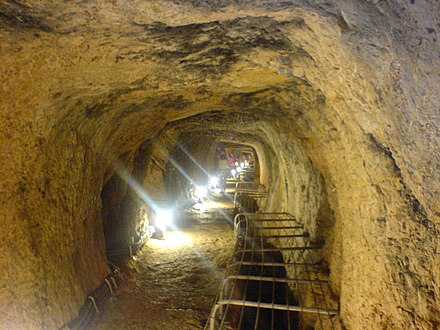
- The mole, 37.68792°, 26.94347°. It was the first technical port built in the Mediterranean. The mole which protected the harbor was 360 meters long and based in 30 meters of sea depth. Today, the western end of Pythagorion quay conspicuously consists of this ancient project which constitutes also the root of the outer mole.
- The Tunnel of Eupalinos, 37.69462°, 26.93012°, +30 22730 61400. A tunnel of 1036 m was hewn through the hill and below the city’s defensive wall to serve as a safe aqueduct in case of siege while providing an escape route. What made it an extraordinary engineering feat and a project management paradigm is the fact that two different teams begun simultaneously from both sides of the hill and they succeeded, with a negligible deviation, to meet just under the top of the hill in 180 m of depth, despite they were obliged to deviate from straight line due to frailty rocks.
- Temple of Hera (Heraion of Samos), 37.67142°, 26.88494°, +30 22730 62811.
Other archaeological sites
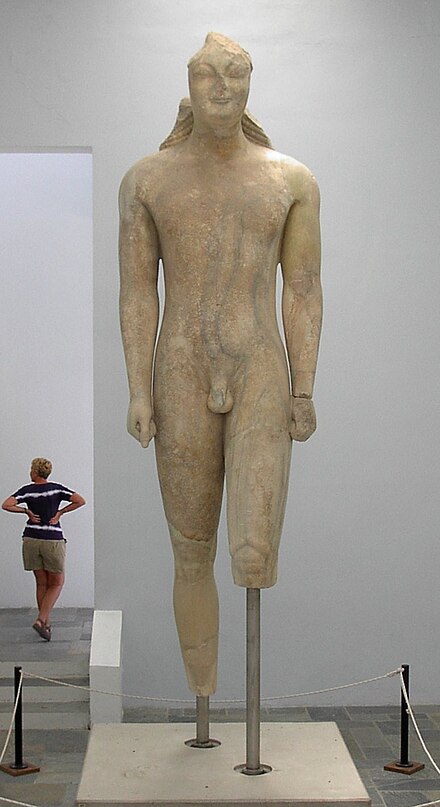
_Museum.jpg/440px-Vehicle_at_Samos_(Vathi)_Museum.jpg)
-
The cyclopean wall, 37.69794°, 26.9419°. The ancient city’s defensive wall of polygonal masonry was 6220 m long. The Samians were forced to demolish it following their defeat by the Athenians in 440-439 BC, but soon after they built it again. Today remains its northern part at the top of the hill above Pythagorion, so it can be visited.
-
Ancient Mines, 37.70365°, 26.91848°. The workmen of ancient Samos were extracting soft limestone with primitive tools which was used in the temple of Hera and for construction of city buildings. The mines have forty-five entrances and eight levels. As of today many old inhabited houses in Pythagorion conspicuously incorporate structural elements which were molded in ancient times.
-
Pythagoras' cave, 37.7275°, 26.66111°. It was used by Pythagoras as part of initiation of students at an early stage, where they were standing a test. According to local legend, he sought refuge there when he was chased by the tyrant Polycrates prior to his final departure for the Doric city of Croton, in Sicily.
Museums
- Archeological museum of Pythagorion, 37.69139°, 26.94°, +30 22730 61400. Houses mainly findings from Pythagorion associated with the everyday life of the ancient inhabitants.
- Archeological museum of Vathi, 37.75444°, 26.97889°, +30 22730 27469. Houses mainly findings from Hereon, among them, the largest 5.5 m surviving Kouros in Greece.
- Paleontological museum, 37.72253°, 26.91014°, +30 22730 52055. It houses a priceless paleontological treasure consisting of the fossilized bones of megatheriums which lived 8-10 million years ago. Many of these are unique paleontological findings and witness the natural history of the European continent. Approximately 30,000 fossilized bones that found the previous century were taken away abroad and now adorn the most important natural history museums in the world. Find in the museum the fossils which remained in Samos.
Old Monasteries
- Panagia Vrontiani, 37.78181°, 26.84514°, +30 22730 93255. Was founded in 1476 and rebuilt in 1566 on the ruins of an older monastery, dedicated to the natal of Virgin Mary. It is famous for its carved iconostasis, stunning frescoes and icons, many sacred vessels and books and codices dating from 1676.
- Holy Cross, 37.70822°, 26.87164°, +30 22730 91278. The original building was built in the early 17th century, according to an inscription on the cross that was placed in the foundations of the temple. The global founded in great depth and mounted on wooden beams took its current form in 1838. Its rood screen is a work of outstanding quality, as is the pulpit and the bishop's throne. Has a close relationship with the Jerusalem Patriarchate because among the Sacred Relics of exists a piece of Holy wood, which is set for veneration.
- Megali Panagia, 37.69544°, 26.84253°, +30 22730 41249. Founded in 1586 on the South side of Samos and is dedicated to the Assumption. Suffered many invasions and plundered by pirates and barbarians. Inside the Catholic, it is rescued the old marble tiling with composite umbilical in the center. The bas-relief is framed by early Christian marble slabs. The whole church is painted by unknown painter, who must have known the art of Athos.
- Prophet Elias, 37.77544°, 26.71903°, +30 22730 32279. Founded on an existing temple that was donated in 1625 and later the monastery was built around. The Monastery has some beautiful wall paintings, many ecclesiastical utensils and a wooden carved icon-screen.
Architecture
The island's highland villages maintained satisfactorily their architectural character. From the coastal villages, Pythagorion and Kokkari maintain in full their architectural tradition as it is protected. Vathi , although a modern city, has some interesting buildings, concerning history and architecture, like the Samian Parliament. At the square near Vathi waterfront there is the "Lion" marble monument, more than 2 meters high, which is an exact replica of the lion of Amphipolis and the other lions built by Philip II of Macedon. Some other villages worth visiting are the old town of Karlovassi, Marathokampos, Platanos and Ampelos, where you can find a path through the mountain with some nice views and great small waterfalls.
Festivities
 There are numerous festivities in the island’s villages held all over the year, especially in the summer. These are either religious fairs or fests related to local food or beverage products, like the Mitilini fried dough (tiganita) fest or Pythagorion fishermen fest. Their religious or local character is accompanied by traditional food, music and dances that last until the early hours.
There are also three pan-Samian festivities which are organized in August as follows:
There are numerous festivities in the island’s villages held all over the year, especially in the summer. These are either religious fairs or fests related to local food or beverage products, like the Mitilini fried dough (tiganita) fest or Pythagorion fishermen fest. Their religious or local character is accompanied by traditional food, music and dances that last until the early hours.
There are also three pan-Samian festivities which are organized in August as follows:
- Saviour's Transfiguration. August 5th, 1824 was the last day of the naval battle of Mycale strait won by the Greeks who were fighting for their freedom. Especially that day saw the Samiots away of the danger of total destruction (like it happened earlier at Chios, Psara and Kassos) as they had repelled all invasion attempts. The next day, August 6 1824, coinciding with the feast of Saviour's Transfiguration, dawned with thanks giving, rejoicing and fest. In the naval battle decisive role played the Greek fireships. So, every August 5th, in Pythagorion takes place a re-enactment of naval battle with explosions and fireworks at sea and the next day a religious fair is held with folk dancing. It is worth noting that at the same strait, in August 479 BC there was the last naval battle with the Persians who, following the destruction of their fleet, abandoned forever their efforts to enslave the Greeks.
- Wine Festival. Organized by the Union of Vinicultural Cooperatives of Samos and the Municipality of Samos offering all varieties of the local wine - especially the famous sweet wine. Local musicians and dancing groups participate, where dances are danced usually by girls in a circle. Male dancers take up places at the beginning or the end of the chain.
- Heraea. Three-day artistic festivity which includes ancient musical, poetic and choreο-theatrical performances that frame the central event. The pinnacle of the celebration starts in the second evening with torch relay (women compete in running with torches), and continues with the arrival of the flame and the women procession with the woven veil of Hera by following the ritual from the 6th century BC.
Do
Swimming and sunbathing
There are beaches, both sandy and shingle, all around the coast so swimming and sunbathing are popular activities. The water is very clear but cold up until May.
- Gagkou, 37.765340°, 26.964993°. Small pebbly beach, 200 m long, that is protected from the winds with relatively shallow waters. This is a pebble beach but there are areas of sand in the water. It is the nearest major beach to the town of Samos (Vathi), a 15-minute walk with the sea on your left from the ferry port. You can rent sun loungers and there are bars/cafes on the seafront although you may not be able to consume their food and drink on the beach itself.
- Livadaki, 37.7942822°, 26.9843535°. Small exotic beach, about 100 m long, with light sand and shallow turquoise waters, located in a small and narrow bay between rocks. It is organized with umbrellas, sun beds and beach bar.
- Agia Paraskevi (Galazio), 37.7807988°, 26.9918336°. Pebbly beach with clear deep water and small trees for shade. In the area there is a taverna offering fish and seafood.
- Kerveli, 37.7291188°, 27.0358730°. Pebble beach about 200 m long having relatively shallow waters and sheltered from the winds. The beach is surrounded by a green scenery, it is not organized and ideal for relaxing. In the area there are restaurants, small hotels and lodgings.
- Mikri and Megali Lakka, 37.757975°, 27.024865°. Both beaches have deep water and are accessible by foot or by boat.
- Poseidonion, 37.7134953°, 27.0571358°. Small pebble beach, 200 m long, with relatively shallow and clear turquoise waters. The beach is organized with a few sun beds and umbrellas and is suitable for a family holiday. Close to the beach and in the wider area are small hotels, rooms to let, bars and seaside tavernas.
- Klima, 37.710122°, 27.045427°. Small pebble beach with shallow, clear waters and well protected from the winds. At the beach and the surrounding area, there are lodgings and tavernas.
- Mycale, 37.7057723°, 27.0046692°. It is a white long beach approximately 3 km, with pebbles and crystal clear emerald waters with moderate depth. The beach is well organized with sun beds and umbrellas, but there are also trees along that offer shade. In the area there are tavernas and snack canteens located by the sea.
- Psili Ammos, 37.707913°, 27.017540°. Small beach, about 200 m long, with very fine sand, very shallow, clear waters and well protected from the winds. It is organized and has umbrellas and sun loungers. In the area there are tavernas, big hotels and lodgings.
- Plaz Pithagoriou, 37.690185°, 26.934447°. Small beach about 100 m with pebbles and sandy bottom having moderate water depth and protected in the bay of Pythagorion. The beach is well organized with sun beds, umbrellas and shower. In the area there are restaurants, big hotels and lodgings.
- Potokaki, 37.687380°, 26.920403°. Long beach of 3 km approximately, with sand and pebbles having moderate water depth. Offers a variety of services such as umbrellas, sun beds, shower facilities, beach bars, beach volley and water sports equipment, while there are many places that offer tranquility and comfort. In the area there are restaurants, big hotels and lodgings.
- Votsalakia (Campos), 37.707309°, 26.665735°. Extended long beach 3 km of sand and pebbles. The water is moderately deep and crystal clear. Organized beach with umbrellas, sun beds and water sports. There are small hotels, many lodgings, bars and fish tavernas. During the summer months has a lively nightlife.
- Chrisi Ammos (Psili Ammos), 37.704029°, 26.644011°. It is the most beautiful beach of the island, about 400 m long with shallow water and sand. It is organized with umbrellas, sun beds and a restaurant. In the region there are lodgings.
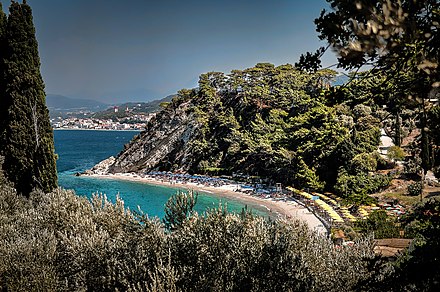
- Kokkari, 37.7778220°, 26.8971761°. A pebble beach with deep clear waters. When northern winds blow high waves are created. It is well organized, with umbrellas and sun beds, beach volley, beach soccer, beach tennis, table tennis and equipment for water activities - water sports, such as windsurfing, canoeing, pedalo, scuba diving. There are many lodgings and small hotels as well as tavernas and bars by the sea.
- Lemonakia, 37.782545°, 26.876662°. The beach is about 400 m long with clear waters. When northern winds blow high waves are created. The beach is well organized with sun beds and umbrellas. There is a taverna next to the sea and rooms to let near the beach.
- Tsamadou, 37.785848°, 26.872794°. It is a pebble beach about 400 m long with turquoise and crystal clear water that deepens abruptly. When northern winds blow high waves are created. It is one of the most beautiful beaches of the island, where few nudists gather mostly on the right side. It is organized with umbrellas and sun loungers. There are tavernas and beach bars along the beach.
- Tsabou, 37.802335°, 26.854604°. It’s a small beach of 350 m with pebbles, deep and clear water where high waves are created when strong northerly winds blow. Right after there is a smaller secluded beach. The beach is well organized with sun beds and umbrellas and a taverna close to the coast.

- Potami, 37.789874°, 26.663551°. An extensive beach of 800 m with fine pebbles and crystal clear waters, where high waves are created when northern winds blow. It is organized in some part with a few lounge chairs and umbrellas and a beach bar. In the beach area there is a cafeteria and a restaurant.
- Mikro Seitani, 37.77727°, 26.646704°. It is a small pebble beach of 150 m with deep and clear water in a wild and majestic scenery. The beach is completely isolated and unorganized. The only way to reach the beach is to walk two kilometers from the place Potami to Megalo Seitani.
- Megalo Seitani, 37.769342°, 26.635282°. It is one of the most beautiful beaches of the island, 350 meters long, with thick sand and deep clean waters. Approached from Mikro Seitani, as above, where the trail continues for another 2 km around a stunning route with great views. There is also a daily excursion to the beach by boat from the port of Karlovassi. The visitor should be equipped with the necessities as the beach is completely isolated. Megalo Seitani has been declared a Special Protection Zone for the seal Monachus monachus and it is a part of the network Natura 2000.
Walking and hiking
There are innumerable places of exceptional beauty at the beaches and on the mountains of Samos, including cultural heritage places. Many of these are easy to access and there are a lot printed guides at souvenir shops in many languages with the help of which one can reach these places.
- An easy walk from Vathi (Samos’ capital). Walk the coastal path from Gagkou Beach (see above for directions) through beautiful flora and see the crystal clear coves. From Gagkou beach head over to the half-finished concrete building. Head up the steps of this, cross the first floor and you'll see a path off into the heather from here. You can follow this path for a couple of kilometres until it leads you back to the road. It's a great place to watch the sunset and you can get down to one or two deserted although very small beaches via this path.
- Samos Outdoors, 83200 Néon Karlóvasi, info@samosoutdoors.com. Offers outdoor activities like adventure weeks, hiking tours, cycling tours, MTB, climbing, river trekking, and organized visiting to unique beauties of the island which have various degree of access difficulty.
- Potami waterfalls. A great adventure for anyone who is around the Karlovasi area. You can get easily to the first waterfall but getting to the big one it's a bit of a challenge. You can ask the locals for more info. It will take you approximatelly, 30-45 minutes. 2016-02-09
- Kerkis summit (1.444). It's the biggest mountain in the island and one of the highest in the Aegean sea, 1,444 m above the sea level. There's a path that you can take just outside of Marathokampos, it takes about 3-4 hours to reach the top. 2016-02-17
Watersports
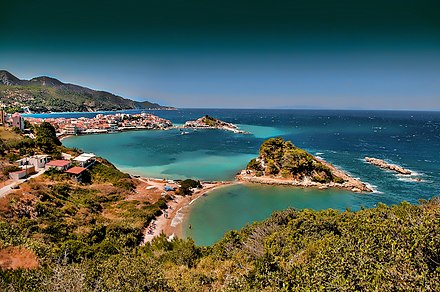 There are watersport facilities in the beaches of Potokaki, Kokkari, Votsalakia and Mycale.
There are watersport facilities in the beaches of Potokaki, Kokkari, Votsalakia and Mycale.
- Potokaki. Excellent watersports facilities to be found on the long pebble beach at Potokaki, which are open all season. Including windsurfing, waterskiing, inflatables and jetski hire.
- Kokkari. Very popular windsurfing destination, where various facilities are offering such services.
- Samos Windsurfing, Kokkari - N37°46’44.87”, E26°52’48.53”, 37.779131°, 26.880147°, +30 6938 929571. Apart from its excellent facilities, “Samos Windsurfing” offers also windsurfing courses.
Yachting
Either from the ancient port of Pythagorion or from the adjacent modern marina, there are many options for a sailing itinerary depending on the time available. One direction is the westbound sailing tour that includes the islands of Ikaria, Fourni and Thimena, as well as several beaches of Samos which are only accessible from sea or from steep trails. The other direction is toward the numerous islands to the south, up to Patmos, up to Kos, or even up to Rhodes.
- Sailing Heaven, Pythagorion 83103, +30 6972 702 594, sailingheaven@otenet.gr. Offers yacht charters and sailing holidays to the nearby Greek islands on a bareboat or skippered boat charter.
Daily sea excursions
Swimming in the crystal clear waters of inaccessible Aegean beaches is a captivating and unique experience. Traditional Greek sailboats (kaiki) and other kinds of boats organize daily excursions where there is plenty of time for sunbathing, swimming and photography. In certain excursions food is provided, cooked by the crew. Tickets can be bought from the previous evening or even the same morning if there is availability.
- Depart from Pythagorion to Tsopela beach or Samiopoula islet.
- Depart from Karlovassi to Megalo Seitani beach which has been declared a Special Protection Area for the seal Monachus monachus.
Buy
 Wine is the main product of the island. The famous muscat wine is exported all over the world. The sweet Samos Vin Doux, a muscat wine, is a very popular dessert wine. Have one after diner and you will probably take some bottles home. Being a sweet wine one must drink carefully. Superior qualities are the Nectar and the Anthemis, the last being aged for five years before bottling.
Wine is the main product of the island. The famous muscat wine is exported all over the world. The sweet Samos Vin Doux, a muscat wine, is a very popular dessert wine. Have one after diner and you will probably take some bottles home. Being a sweet wine one must drink carefully. Superior qualities are the Nectar and the Anthemis, the last being aged for five years before bottling.
The island’s pottery long tradition
- Fair Cup (dikaia koupa). The "cup of Pythagoras" has a line that determines the limit of fulfillment. The cup empties from its bottom when filled more than the limit. With this invention, called also "the fair cup", Pythagoras wanted to teach his students the necessity of applying measure and limits in their lives and why greed is vituperation which causes divine retribution. When the limit was outdone (hubris), lost was not only what was in excess of the limit but also what had been obtained up to then (retribution).
- Water Whistle (nero-sfyrihtra). When the pot is full of water and air is blown to the tube, air bubbles pass through the water emitting a gargling whistle. When air is blown to the tube and the pot is empty the pot emits continuous hiss.
- The laughable jug (mascara bardaki). The pleasantries that causes is that before the unwary drink from the spout, is getting wet all over from the holes. The challenge is to find the way to drink water without getting wet.
Eat
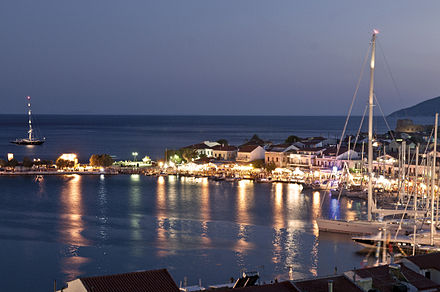
- The Garden restaurant serves good value Greek and western food and is very close to the centre of Samos. It's on, Manolis Kalomiris Road, the second street back from the sea front and is well-signposted. The restaurant is outdoors under vine leaves with a fountain and some songbirds and traditional Greek music to add atmosphere. Children will enjoy being photographed on the concrete donkey in the corner too. The Greek Salad for two is good value at €6 and a generous glass of wine is the cheapest drink on the menu at €1.50.
- The seafront has a range of restaurants with typical Greek fare as well as pizzeria.
Drink
Although the town of Vathy is the capital of the island, there's no doubt that Karlovasi town is the place to be when it comes to drinking and partying. And that's because of the almost 2,000 students that study in the university there - especially during the winter. You can find a big variety of cafes, taverns, bars and clubs there.
Also, if you want to find a place to "dance the night away", in Greece people go to night clubs usually after 02:00.
-
There are numerous places to get a drink along the seafront and these get very busy in the evenings.
-
The main square of the town has open air cafes where you can get a coffee and enjoy the sun.
-
BaRRock Alternative Bar. Propably the only alternative bar/club in Karlovasi. It's located in the square of Meseo Karlovasi and it's a great little place to drink a couple of beers and dance the night away. They host trap, techno, trance, hip hop and rock nights. Open only on Friday and Saturday until early morning. 2016-02-09
-
Barcode club. Another small, great club. You can hear mainly deep house music, open Friday, Saturday. Along side with Jasmine and Gazi, it's one of the most popular clubs in Karlovasi. 2016-02-09
-
Ginger cafe/bar. Very nice atmosphere, in a Paris-like cafe, in Karlovasi. Great variety of food, different types of coffee, tea and wine. Every Tuesday they host "Tapas nights" where you can have five types of tapas with a glass of red wine with only €4.50! 2016-02-09
-
Jasmine Club. Great club right in the heart of Karlovasi, just 2 minutes from the central square. Plays the mainstream international hits until about 3 and after that, Greek "turbofolk" music. The place is kinda small (can't handle more than 60-80 people) so it gets packed really fast and the party goes on until the first morning hours. Decent prices, a beer is about €3 and a drink is around €5. Free entrance. 2016-02-09
-
Azucar cafe/bar. In the square of Karlovasi. Small, relaxing place with good beer and nice deep house music. They host karaoke nights or small acoustic lives from time to time. Check their facebook page for any upcoming events. 2016-02-09
-
Garage. A bar in the port of Karlovasi which turns into a night club on the weekends. You can listen to all types of music - from Greek to Jazz or 1980s disco. 2016-02-09
-
Tamam. Another tavern in the square of Karlovasi. Every Tuesday and Thursday they have a "drink as much wine as you can" deal with €4 per person. 2016-02-09
-
Algorithmos. A cafe run by students, on the building next to the dorms. You name the price on whatever you take. Works around the university timeline so if you visit in the middle of summer, there's a high chance that it's going to be closed. The place is nicely decorated, with a view of the town of Karlovasi and with different events happening every week. 2016-05-19
Sleep
Off season (i.e. Oct-May) you can bargain rooms down to as little as €20 for a double.
-
Anema Hotel, Kanari 83, 37.79542°, 26.69003°, +302273030500, info@anema.gr. 2016-01-18
-
Arion Hotel. The hotel consists of 108 rooms, divided between the main building and a bungalow complex. Their large verandas overlook the Aegean Sea and the lush green surroundings.
-
Kokkari Beach Hotel. A friendly family-run beachfront hotel.
-
Saint Nicholas Hotel. On Mykali beach.
-
Pythagoras Hotel. Opposite the hospital is a dated concrete slab, although this may be where you can get the cheapest room in high season. Be prepared for negligible service though and make a note that although they claim breakfast, lunch and dinner can be served "anytime," the Internet is unavailable between 22:15 and 23:00 while the owner has his evening meal. Rooms facing the hospital are cheapest at €22 per night in low season without breakfast. During high season, rooms with two single beds facing the harbor are €30.
-
Armonia Bay Hotel, Kokkari. A wonderful, small hotel with stunning views, infinity pool and lovely staff..
-
Olympia Beach, Kokkari beach (on the main beach road of Kokkari going towards Tsamadou), 37.7786°, 26.8882°, +30 22730 92420. On Kokkari's main beach in a two-storey building, Twelve double rooms which all feature en-suite bathrooms, satellite TV and controllable air-conditioning, All the rooms have balconies offering an unobstructed view of the Aegean Sea. Cleaning and change of linen is daily. €60
-
Astra Village Hotel. Hotel with amazing view in Pythagorion.
-
Stratos Hotel. Low cost hotel at Pythagorion.
-
Fito Aqua Bleu Resort, P.B 40, Pithagorio, +30 2273 062900, info@fitobay.gr. On the southeastern side of Samos, 800 m from the cosmopolitan village of Pythagorion.
-
Ino Village Hotel, 69, Samion Agoniston St, +30 22730 23241, +30 6932441118, info@inovillagehotel.com. Ino Village hotel is in Kalami, 15 minutes by foot from the center of the island, and it has 65 rooms.
-
Nafsika Villas, Kerveli, +30 22730 25175. Information, facilities, rates for Nafsika Villas located in Kerveli Samos €45
-
Ledra Samos Hotel, Kambos, Marathokambou, 37.707311°, 26.662949°, +30 2273037505. Check-in: 14:00, check-out: 12:00. Surrounded by breathtaking scenery and natural beauty.
-
Leto and Lemos Hotels. Seaside hotel.
-
Mouzakis Villas, Agia Paraskevi Nisi, 37.7772°, 26.9895°, +30 6946462189, info@mouzakisvillas.gr. A complex of 3 detached villas with private swimming pools in each one of them. Great views to the sea and to the mountain.
-
Polyxeni Hotel, +30 22730 61590. Sea-front hotel and cafeteria at Pythagorion Village.
Connect
Go next
Ferries to other Greek islands are numerous including many to Piraeus (for Athens). Usually, there's an overnight ferry leaving at 22:30 and arriving in Piraeus 9 hours later via Ikaria and Mykonos. Prices for Piraeus start at €42.50 on the comfortable Hellenic Seaways boats. Travel agents clustered around Samos port can sell you tickets.
Take the ferry to Kusadasi in Turkey and admire the ancient monuments of Ephesus, one of the major and best preserved Greco-Roman sites in Turkey,
Samos
samos.grNomós Sámou
2nd-order administrative division
North Aegean Region
Primary administrative division
